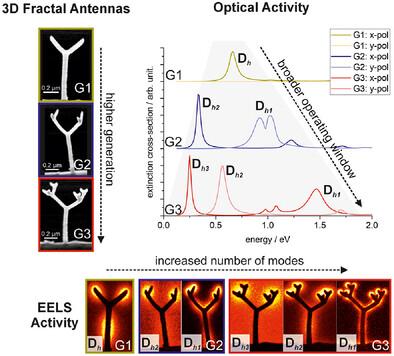利用三维纳米打印技术实现多向、独立的三维等离子体纳米结构——以分形天线为例
IF 19
1区 材料科学
Q1 CHEMISTRY, MULTIDISCIPLINARY
引用次数: 0
摘要
该研究展示了精确工程的三维等离子体纳米结构的实现,该结构能够在三维空间中操纵和重定向光信号。由于增加了设计自由度和减少了衬底的影响,将纳米结构提升到第三维度可以显着扩展电流激发/发射的可能性和信号强度。到目前为止,金属基三维纳米结构的制造面临着巨大的挑战,无论是由于材料还是设计。在这里,金基3D纳米结构通过聚焦电子束诱导沉积(FEBID)沉积,并通过在水蒸气中蚀刻提纯——这一过程在独立设计的情况下尤其难以控制。通过从相反的90°侧视图交替照射结构,可以成功地利用光束方向的影响,从而确保在不影响结构保真度的情况下有效地去除碳。这个新引入的方案在分形树冠树的案例中得到了证明,分形树冠树由具有不同长度和直径的独立纳米线组成,以确定的角度定向,形成不同复杂性的分形天线。等离子体响应在数值上和实验上都得到了证明,通过快速电子激发,显示出宽带等离子体活动,可定制的极化率和与模拟的良好一致性。这种定向纯化策略现在使3D等离子体纳米结构的可重复性制造成为可能,并有望显著提高3D纳米等离子体的实验能力和理解。本文章由计算机程序翻译,如有差异,请以英文原文为准。

The Realization of Multidirectional, Free-Standing 3D Plasmonic Nanostructures via 3D Nanoprinting: A Case Study of Fractal Antennas
This study demonstrates the realization of precisely engineered 3D plasmonic nanostructures capable of manipulating and redirecting optical signals in 3D space. Lifting nanostructures into the third dimension can significantly extend current excitation/emission possibilities and signal strength, due to increased design freedom and reduced substrate influence. So far, the fabrication of metal-based 3D nanostructures poses significant challenges, attributed to either material or design. Herein, gold-based 3D nanostructures are deposited via Focused Electron Beam Induced Deposition (FEBID) and purified through etching in water vapor – a process particularly hard to control in the case of free-standing designs. By alternately irradiating the structures from opposing 90° side views, the impact of beam direction can be successfully leveraged, thereby ensuring efficient carbon removal without compromising structural fidelity. This newly introduced protocol is demonstrated for the case of fractal canopy trees, composed of free-standing nanowires with distinct lengths and diameters, oriented at defined angles to form fractal antennas of varying complexity. Plasmonic responses are evidenced both numerically and experimentally via excitation with fast electrons, showcasing broadband plasmonic activity, customizable polarizability and excellent agreement with simulation. This directional purification strategy now enables the reproducible fabrication of 3D plasmonic nanoarchitectures and is expected to significantly advance experimental capabilities and understanding in 3D nanoplasmonics.
求助全文
通过发布文献求助,成功后即可免费获取论文全文。
去求助
来源期刊

Advanced Functional Materials
工程技术-材料科学:综合
CiteScore
29.50
自引率
4.20%
发文量
2086
审稿时长
2.1 months
期刊介绍:
Firmly established as a top-tier materials science journal, Advanced Functional Materials reports breakthrough research in all aspects of materials science, including nanotechnology, chemistry, physics, and biology every week.
Advanced Functional Materials is known for its rapid and fair peer review, quality content, and high impact, making it the first choice of the international materials science community.
 求助内容:
求助内容: 应助结果提醒方式:
应助结果提醒方式:


